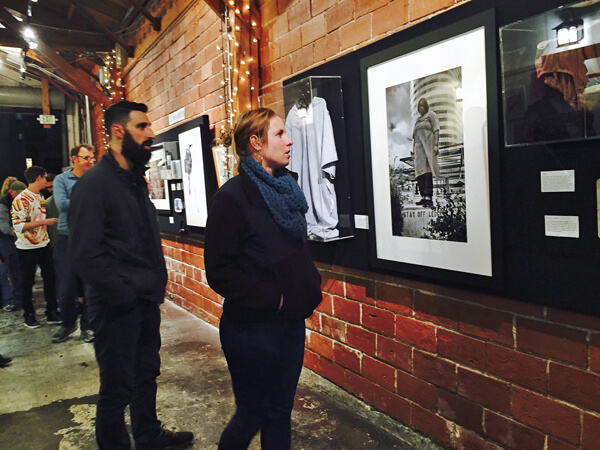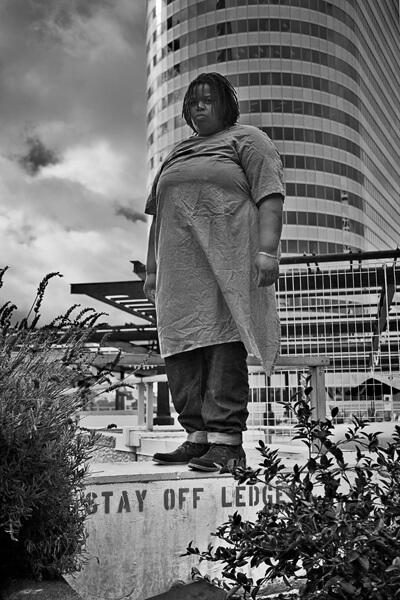The Foster Youth Museum, eight years in the making, had a resoundingly successful gallery show at Warehouse 416 in Oakland last month. Over two thousand people visited the exhibit, “Lost Childhoods,” a curated collection of art and artifacts donated by former foster youth that, in the words of museum co-director Jamie Lee Evans, are “the stories no one else will tell.”
This first public exhibition of the museum, despite being open only on Saturday afternoons and a couple of evenings in March, not only drew crowds but also buzz on social media and coverage in outlets such as Oakland Local, San Jose Mercury News, and UC Berkeley’s California Magazine.

Visitors tour the Lost Childhoods exhibit of the Foster Youth Museum at Warehouse 416 in Oakland. Photo: Jamie Lee Evans
Conceived and produced by current and former foster youth, the museum is a project of the Y.O.U.T.H. Training Project (YTP) of California Youth Connection, a statewide program that develops the leadership of current and former foster youth to impact and improve the systems affecting transition-age youth.
Having originally created the museum as part of their curriculum to train child welfare professionals, YTP decided to display it publicly in order to reach the larger community, and brought on Ray Bussolari, a professional photographer who curated the exhibit while completing his master’s in Museum Studies.
Throughout March, visitors steadily lined up at Warehouse 416 on sunny Saturday afternoons to see objects evoking the loss and sense of powerlessness children in foster care experience as well as items affirming their resilience and success. Many of the items are well worn from years of being carried from one foster home to the next.
The section about loss included a purple teddy bear given to a foster youth by her sister from whom she was separated, Monopoly money with a grandmother’s phone number hastily written on the back, a long letter sent from prison by a father to his daughter. Around the corner, visitors saw emblems of “hope and transformation”: a college diploma, a photograph from a wedding, a pair of Stanford women’s rugby shorts.

Captain Young models the hospital gown he donated to FYM in Oakland, California. Photo: Ray Bussolari raybussolari.com
This ‘turning the corner’ aspect of the museum is crucial to its intention to show what the foster youth who donated items to the exhibit say helped them overcome grief and disruptions in their lives to become successful and happy. Objects in this section represent educational achievement, healthy long-term relationships, and the experience of being an advocate and making, as Evans puts it, “an impact on the system that was painful to them and broke their hearts.”
Now the museum’s empty vitrines and the objects they displayed are back in storage, “not well packed, not in a temperature-controlled space,” according to Evans. While the museum has just received an individual donation to help cover the cost of properly packing and storing the items, much more funding is needed so that a curator can be hired, the articles can be preserved long term, ideally in a permanent location, and the museum can respond to the dozens of requests from organizations around the country wanting to bring it to their communities.
Evans hopes the museum finds a patron “who really cares about foster youth, to fall in love with our vision and partner with us in getting this work out into the community. Every time we show, we hope we’ll meet that person.”
“And until then,” Evans adds, “we’ll keep writing grants.”
The museum thus far has been funded by grants from the Zellerbach Family Foundation, the Stuart Foundation and The California Wellness Foundation.
Bussolari, who curated the exhibit and remains committed to the project, primarily as a volunteer, says, “In all museums, a main mission is to preserve the artifacts.” In the Foster Youth Museum, there is a doubly profound reason to do so: “These are things foster youth have carried with them forever, things we want to preserve and respect.”
One visitor to “Lost Childhoods” expressed to Evans his surprise that former foster youth would choose to donate their possessions. With so few foster youth graduating from college, (a 2010 study found that 6% of former foster youth had earned a college degree by age 24) the visitor asked how this young person had been willing to give up her framed diploma. Evans recalls the guest nodding toward the purple teddy bear and saying: “If that was mine, I’d hang onto its last thread.”
“The truth is people are really excited to donate their items because they know they will live on,” Evans says. “When someone is going in and out of homelessness, as many former foster youth are, it’s not so easy to hold onto things.”

CYC Meredith Ku demonstrates a too common experience for foster youth in a photograph taken for Foster Youth Museum presents Homeless Exhibit. Photo: Ray Bussolari raybussolari.com
The museum’s many items made of paper, cloth, even the photos, can break down, says Bussolari, when exposed to temperature changes or humidity, as they are in their current storage location, a garage. At this point, the museum does not have the resources to store the items properly, nor do most organizations wanting to display them have the funds to pay for the type of shipping required.
“There are so many lonely truths in foster care,” Evans says, yet “foster care can be solved with community. The Foster Youth Museum shares that story with the world with intensity and seriousness and dignity.”
She adds, “We won’t be able to build on the momentum we’ve earned without more funding.”
Evans and her team hope the support needed to sustain The Foster Youth Museum is just around the corner. Meanwhile, a gallery’s worth of belongings donated by young people willing to let them tell a story larger than themselves waits in storage.
Melinda Clemmons is a reporter and marketing manager for The Imprint.

